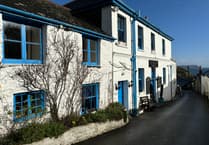Thursday, March 29,1923
There was an added attraction to market day in Penzance, as motor-cyclists passed through on their way to from London to Land’s End.
One of the riders taking part in the Motor Cycling Club’s reliability trial, Mr Strong of Sidmouth, claimed to have invented a new fuel which could be made by adding a secret ingredient to water, and cost only 4d – under 2p – a gallon.
He was reported to have ignored a warning to ‘drop the whole thing for good’ if he valued his life, and to have found that the new fuel performed well – although after one of the bottles had been accidently smashed, he had resorted to ordinary petrol.
Mr Strong was recognised and cheered on his way through Penzance, driving his Harley Davidson motor cycle and sidecar, but nothing more was heard of his invention.
The weather had been fine for the entire run, with bright moonlight after dark, which was useful given the poor state of many of the roads along the route.
Although several of the participants dropped out, one crashed and another hit a wall, 264 finished the course – and the turned and set off back to London. The motorcycle cavalcade came through Penzance again after dark, this time providing a brightly lit evening spectacle.
Friday, March 30, 1923
For the second time in 24 hours, crowds gathered in the Greenmarket – this time to witness a new initiative by the Church of England: Good Friday parades.
Processions left St Mary’s church at 5.50 pm and St John’s at 6pm. Their routes were carefully planned and timed, with the St Mary’s congregation heading for the Quay area, New Street and the Greenmarket while the St John’s marchers walked to the Battlefields area and then down to the station, where they were met by a third group coming into town from Gulval.
All three groups then combined in a synchronised manner, making their way down Chapel Street for a service at St Mary’s conducted by the Bishop of Truro.
Wednesday, April 4, 1923
The directors of East Pool Mine were predicting a strong future for tin, and announced the issue of 100,000 new five shilling shares.
This would raise £25,000 to exploit a newly-discovered tin lode, market the tin at an early date and take advantage of good prices: tin was now fetching £200 a ton. The new lode was situated over 1,000 feet below ground.
It had been named after one of the principal shareholders, Mr Moreing, who was optimistic that demand for both tin and arsenic would remain high.
Dolcoath was also looking for investors, and had been promised a government loan of £65,000 if it could raise another £55,000.
The directors hoped that, with the extra investment enabling greater output from the Roskear mines, they might be able to raise output to 1,000 tons a year - and create jobs for hundreds of local workers.





Comments
This article has no comments yet. Be the first to leave a comment.